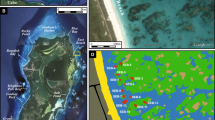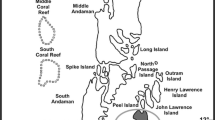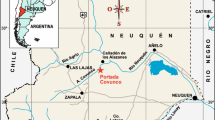Abstract
Microbes and microbial carbonates in reef-flat and coral community dynamics and submarine geomorphologic features in reef crest and fore reef of Yongxing Island, the Xisha Islands, South China Sea, were studied by means of scuba diving, underwater investigation, and line intercept transect survey. Studies indicate a very high coral mortality with few living corals in the reef flat of Yongxing Island. Moreover, macro algae, sea grass and cyanobacteria are common in reef flat. Microbes and microbially induced carbonates occur in reef flat. Living corals grow mainly in the reef crest and fore reef, but are also declined dramatically. From coast to off shore, the southeast reef flat of Yongxing Island can be divided into beach, inner reef flat, outer reef flat, reef flat front (reef crest and fore reef), and fore-reef slope settings. Sedimentary facies include coast, reef flat, reef crest and fore reef, and fore-reef slope. Reefal carbonate sediments are composed of coral skeletons and framework, coral fragments, bioclasts, and lime mud. With the deterioration of environment and water quality, the coral communities tend to be distributed in the reef crest and fore reef with clean sea water, well circulation and moderate water energy. Reef flat is occupied mainly by the macro algae and Heliopora coerulea communities. The coverage statistics on the reef crest demonstrate that the coverage of Acropora cytherea is more than 28% and represents a dominant species with wave-resistant ecological type. Sedimentary characteristics and geomorphologic features are different between the southeast and northwest reef-flat fronts (reef crest and fore reef) of Yongxing Island. The former shows discontinuously tidal channels in outer reef flat and different dimensional and deep reef ponds in reef crest and fore reef, and the latter presents a typical spur-and-groove system. Microbes (cyanobacteria Lyngbya sp.) occur generally in the inner reef flat and reef ponds of reef crest with restricted water circulation. Widely algae growth indicates a eutrophic environment, and the common microbes on the coral surface in the reef flat and reef ponds also demonstrate eutrophication in seawater and deteriorated water quality.
Similar content being viewed by others
References
Hoegh-Guldberg O. Climate change, coral bleaching and the future of the world’s coral reefs. Mar Freshw Res, 1999, 50: 839–866
Wilkinson C. Status of Coral Reefs of the World. Global Coral Reef Monitoring Network & Australian Institute of Marine Science, Townsville, 2004. 553
Hallock P, Bames K, Fisher E M. From satellites to molecules: A multiscale approach to environmental monitoring and risk assessment of coral reefs. J Environ Micropal Microbiol Meiobenthol, 2004, 1: 11–39
Crabbe M J C. Climate change and coral reefs. Biologist, 2007, 54: 24–27
Huang H, Lian J, Huang X, et al. Coral cover as a proxy of disturbance: A case study of the biodiversity of the hermatypic corals in Yongxing Island, Xisha Islands in the South China Sea. Chin Sci Bull, 2006, 51: 129–135
Shi Q, Yan H Q, Zhang H L, et al. Spatial variations of stony coral cover on the reef slope of Yongxing Island, Xisha Islands. Trop Oceanol, 2011, 2: 10–17
Yang H Q, Shen J W, Wang Y, et al. Black band disease as a possible factor of the coral decline at the northern reef-flat of Yongxing Island, South China Sea. Sci China: Earth Sci, in press
Blanchon P. Geomorphic zonation of coral reefs. In: Hopley D, ed, Encyclopedia of Modern Coral Reefs: Structure, Form and Process. Dordrecht: Springer-Verlag, 2011. 469–486
Goreau T F. The ecology of Jamaican coral reefs I. Species composition and Zonation. Ecology, 1959, 40: 67–90
Madin J S, Connolly S R. Ecological consequences of major hydrodynamic disturbances on coral reefs. Nature, 2006, 444: 477–480
James N P, Macintyre I G. Reefs: zonation, depositional facies, diagenesis. Quart Colorado School Mines, 1985, 80: 1–70
Iglesias-Prieto R, Beltrán V H, LaJeunesse T C, et al. Different algal symbionts explain the vertical distribution of dominant reef corals in the eastern Pacific. Proc Biol Sci, 2004, 271: 1757–1763
Precht W F, Miller S L. Ecological shifts along the Florida reef tract. The past is a key to the future. In: Aronson R B, ed. Geological Approaches to Coral Reef Ecology. New York: Springer, 2007. 237–312
Wood R. The ecological evolution of reefs. Annu Rev Ecol Syst, 1998, 29: 179–206
Chappell J. Sea level changes and coral reef growth. In: Barnes D J, ed. Perspectives on Coral Reefs. Townsville: Australian Institute of Marine Science, 1983. 38–55
Buddemeier R W. Corals, climate and conservation. Proc 7th Int Coral Reef Symp Guam, 1993, 1: 1–10
Ammar M S A, Mahmoud M A. Effect of physic-chemical factors and human impacts on coral distributiom at Tobiakebir and Sharmelloly, Red Sea, Egypt. Egyptian J Aquatic Res, 2006, 32: 184–197
Rogers C S. Responses of coral reefs and reef organisms to sedimentation. Marine Ecology Progress Series, 1990, 62: 185–202
Aronson R B, Precht W F. Stasis, biological disturbance, and community structure of a Holocene coral reef. Paleobiology, 1997, 23: 326–346
Zhao H T, Song C J, Yu K F. Nature and development of Yongxing Island and Shi Island of Xisha Islands (in Chinese with English abstract). Mar Sci Bull, 1996, 1: 55–65
Chen S J, Zhong J L. A brief history of the islands in South China Sea. Haikou: Hainan people’s Publishing House, 1989. 1–274
Nakamori T, Suzuki A, Iryu Y. Water circulation and carbon flux on Shiraho coral reef of the Ryukyu Islands, Japan. Continental Shelf Res, 1992, 12: 951–970
Cloud P E. Preliminary report on geology and marine environments of Onotoa Atoll, Gilbert Islands. Atoll Res Bull, 1952, 12: 1–73
Sheppard C R C. The groove and spur structures of Chagos atolls and their coral zonation. Estuar Coast Shelf Sci, 1981, 12: 549–560
Gischler E. Indo-Pacific and Atlantic spurs and grooves revisited: The possible effects of different Holocene sea-level history, exposure, and reef accretion rate in the shallow fore reef. Facies, 2010, 56: 173–177
Rogers J S, Monismith S G, Feddersen F, et al. Hydrodynamics of spur and groove formations on a coral reef. J Geophys Res: Oceans, 2013, 118: 1–15
Schneider J, Le Campion-Alsumard T. Construction and destruction of carbonates by marine and freshwater cyanobacteria. Eur J Phycol, 1999, 34: 417–426
Karl D, Michaels Q, Bergman B, et al. Dinitrogen fixation in the world’s oceans. Biogeochemistry, 2002, 57/58: 47–98
Richardson L L, Kuta K G. Ecological physiology of the black band disease cyanobacterium Phormidium corallyticum. FEMS Microbiol Ecol, 2003, 43: 287–298
Whitton B A, Potts M. The Ecology of Cyanobacteria—Their Diversity in Time and Space. Dordrecht: Kluwer Academic Publishers, 2000. 1–704
Ritson-Williams R, Paul V J, Bonito V. Marine benthic cyanobacteria overgrow coral reef organisms. Coral Reefs, 2005, 24: 629–629
Li Y H, Huang X P, Yue W Z. Environmental quality and management measures inYongxing Islandof Xisha, South China Sea (in Chinese with English abstract). Mar Environ Sci, 2004, 23: 50–53
Bianchi T S, Engelhaupt E, Westman P, et al. Cyanobacterial blooms in the Baltic Sea: Natural or human-induced? Limnol Oceanogr, 2000, 45: 716–726
Albert S, Neil J M O, Udy J W, et al. Blooms of the cyanobacterium Lyngbya majuscule in coastal Queensland, Australia: Disparate sites, common factors. Mar Poll Bull, 2005, 51: 428–437
Zhang Y B, Zhang J X, Sun X L. Advances in influence of seawater eutrophication on marine bacteria(in Chinese with English abstract). Acta Ecol Sin, 2012, 32: 3225–3232
Bell P R F. Eutrophication and coral reefs—Some examples in the Great Barrier Reef Lagoon. Water Res, 1992, 26: 35–68
Charpy L, Palinska K A, Casareto B, et al. Dinitrogen-fixing Cyanobacteria in Microbial Mats of two shallow coral reef ecosystems. Microb Ecol, 2010, 59: 174–186
Titlyanov E A, Yakovleva I M, Titlyanova T V. Interaction between benthic algae (Lyngbya bouillonii, Dictyota dichotoma) and scleractinian coral Porites lutea in direct contact. J Exp Mar Biol Ecol, 2007, 342: 282–291
Zou R L. Study on coral in Xisha Island. In: South China Sea Institute of Oceanology, the Chinese Academy of Sciences, ed. Reports of Oceanic Biology Investigation in the Waters of Xisha Islands and Zhongsha Islands, China. Beijing: Science Press, 1978. 1–328
Li Y H, Huang X P, Yue W Z, et al. Ecological study on coral reef and intertidal benthos around Yongxing Island, South China Sea. Oceanol Limnol Sin, 2004, 35: 176–182
Huang H, You F, Lian J S, et al. Species diversity and distribution of scleractinian coral at Xisha Islands, China. Biodiver Sci, 2011, 19: 710–715
Wu Z J, Wang D R, Tu Z G, et al. The analysis on the reason of hermatypic coral degradation in Xisha. Acta Oceanol Sin, 2011, 33: 140–146
Wang G Z, ed. Sedimentology of Coral Reefs in the South China Sea. Beijing: Oceanic Press, 2001. 1–313
Nyström M, Folke C, Moberg F. Coral reef disturbance and resilience in a human-dominated environment. Trends Ecol Evol, 2000, 15: 413–417
Hughes T P, Baird A H, Bellwood D R, et al. Climate change, human impacts, and the resilience of coral reefs. Science, 2003, 301: 929–33
Buddemeier R W, Kleypas J A, Aronson R B. Coral Reefs and Global Climate Change: Potential Contributions of Climate Change to Stresses on Coral Reef Ecosystems. Report Prepared for the Pew Centre on Global Climate Change, Arlington, Virginia, 2004. 1–56
Carpenter K E, Arbar M, Aeby G, et al. One-third of reef-building corals face elevated extinction risk from climate change and local impacts. Science, 2008, 321: 560–563
Knowlton N, Jackson J B C. Shifting baselines, local impacts, and global change on coral reefs. PLoS Biol, 2008, 6: 215–220
Zhou J D, Yang Z C, Peng S H, et al. The concentrations of dissolved heavy metals in Xisha waters and their influential factors. J Univ Sci Tech China, 2007, 37: 1036–1042
Goldberg J, Wilkinso C. Global threats to coral reefs: Coral bleaching, global climate change, disease, predator plagues, and invasive species. In: Wilkinson C, ed. Status of Coral Reefs of The World. Townsville: Australian Institute of Marine Science, 2004. 67–92
Author information
Authors and Affiliations
Corresponding author
Rights and permissions
About this article
Cite this article
Shen, J., Yang, H., Wang, Y. et al. Coral community dynamics and shallow-water carbonate deposition of the reef-flat around Yongxing Island, the Xisha Islands. Sci. China Earth Sci. 56, 1471–1486 (2013). https://doi.org/10.1007/s11430-013-4677-3
Received:
Accepted:
Published:
Issue Date:
DOI: https://doi.org/10.1007/s11430-013-4677-3




